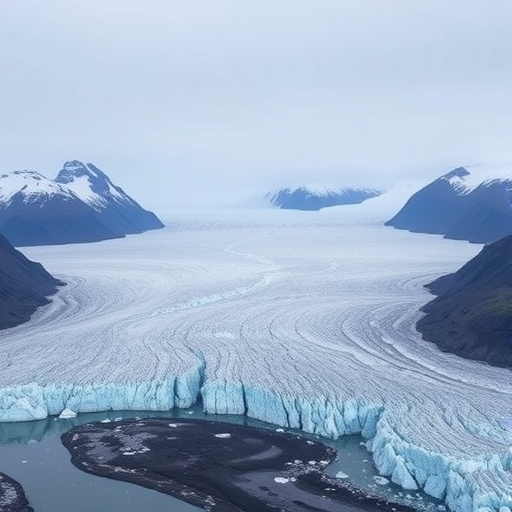In the juxtaposed fjords of Alaska’s Kenai Peninsula, two glaciers—one steadfastly stable and the other having retreated significantly—embody the profound changes climate dynamics can impose on Earth’s cryosphere and the broader marine ecosystems they nourish. A recent investigative study led by researchers at UC San Diego’s Scripps Institution of Oceanography has highlighted a pivotal shift in the bioavailability of essential micronutrients in glacial meltwaters. This shift accompanies rapid glacial retreat and could fundamentally reshape the nutrient cycles sustaining oceanic life in nutrient-limited environments.
Glacial meltwater, murky with suspended sediments, is a vital conveyor of micronutrients such as iron and manganese to the ocean. These trace metals are essential for the growth of phytoplankton—the foundational photosynthetic organisms driving marine food webs and carbon sequestration. However, the new study reveals that glaciers in retreat may be delivering meltwaters with significantly diminished concentrations of these bioavailable, or readily absorbable, metals compared to glaciers that remain fixed in position, implying a nuanced but critical ecological tipping point as Earth’s glaciers dwindle under warming climates.
The team conducted fieldwork in May 2022, sampling sediments, surface waters, and iceberg materials from the northern Northwestern Glacier—an Alaskan glacier which has receded approximately 15 kilometers since 1950—and the nearby stable Aialik Glacier. Given their proximity and nearly identical bedrock substrates, this comparative setup functioned as a natural experiment, allowing the researchers to isolate glacial retreat as a variable influencing nutrient bioavailability independently of lithological differences.
Chemical characterization demonstrated that the proportion of bioavailable iron and manganese in sediment plumes from the retreating glacier was markedly lower than in those originating from the stable one. Approximately 18% of iron and 26% of manganese from the stable Aialik Glacier were bioavailable, compared to just 13% and 14–15% respectively from Northwestern Glacier. These findings hint at substantial mechanistic changes in sediment chemistry wrought by retreat-induced environmental shifts in glacial hydrology and geochemistry.
A critical factor underpinning this differential appears to be the increased residence time and extent of chemical weathering in the sediment plumes sourced from the retreating glacier. As glaciers recede, meltwater and associated sediments must traverse longer terrestrial pathways before reaching the ocean, promoting prolonged water-rock interactions. This extended exposure enhances oxidative weathering and the transformation of micronutrients into less bioavailable forms, reducing their potential utility for marine biota on delivery to coastal ecosystems.
This paradigm challenges the simplistic assumption that more sediment input equates to greater nutrient availability. Instead, the “freshness” of sediment emerges as a pivotal determinant of micronutrient bioavailability—the freshly ground rock flour from active, non-retreating glaciers contains metals in more reactive, bioavailable states due to limited water-induced alteration. Conversely, sediment from retreating glaciers is chemically matured and nutrient-depleted by extended exposure to aqueous and atmospheric conditions within the proglacial environment.
The ecological ramifications of these geochemical processes extend to primary productivity in high-latitude oceans like the Gulf of Alaska and parts of the Southern Ocean, where micronutrient scarcity constrains phytoplankton blooms. Reduced bioavailability of iron and manganese could diminish phytoplankton growth, thereby weakening marine food webs and disrupting the uptake of atmospheric CO2, a natural regulatory mechanism in the global carbon cycle.
Furthermore, these findings have implications for fisheries and indigenous communities reliant on these ecosystems. Diminished nutrient fluxes from retreating glaciers could impact fish populations and, by extension, fisheries productivity and food security. Consequently, understanding how glacial meltwater geochemistry evolves with climate-driven ice loss is critical for anticipating and managing ecosystem responses in a warming world.
The study’s authors caution against overgeneralization, emphasizing that their conclusions stem from a snapshot of merely two glaciers in a specific Alaskan context. The heterogeneity of glacial systems worldwide—in bedrock composition, retreat rates, and hydrological regimes—necessitates broader, multidisciplinary research to ascertain the global prevalence and magnitude of these processes. Such comprehensive assessment would deepen predictive models of how cryospheric changes influence marine biogeochemical cycles.
Support for this cutting-edge research was provided by the National Science Foundation and regional cooperation with national park authorities, underscoring the importance of funding and access in advancing climate and ecosystem science. The collaborative nature of the study—encompassing geochemistry, oceanography, environmental science, and ecology—reflects the multifaceted approach required to dissect complex Earth system interactions.
Looking ahead, further investigations could extend to the temporal dynamics of glacial meltwater chemistry, identifying seasonal variations and long-term trends as glaciers continue to respond to climatic forcing. Integrating molecular-level analyses of trace metal speciation with ecosystem assessments will be integral to unraveling the subtle links between geological processes and biological responses in the marine environment.
In essence, this research illuminates a hidden dimension of glacial retreat—one where the chemical quality, not just the quantity, of meltwater inputs is altered, with cascading effects on ocean nutrient balances and, ultimately, the health of marine ecosystems in a warming planet.
Subject of Research: Geochemical changes in glacial meltwater nutrient bioavailability driven by glacial retreat and implications for marine ecosystems.
Article Title: Tidewater cycle drives alpine glacial sediment plume geochemistry
News Publication Date: 22-Oct-2025
Web References: https://doi.org/10.1038/s41467-025-64731-1
Image Credits: Credit: Kiefer Forsch/Scripps Institution Of Oceanography
Keywords: Climate change, Geochemistry




